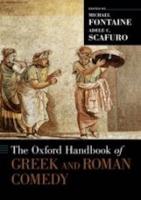
OUP (2018) p/b 894pp £33.50 (ISBN 9780190887216)
‘The 2010s are a watershed moment in the history of comedy scholarship. Comedy’s 2,500th birthday is at hand. Celebrate!’ So says ACS in her introductory survey of recent scholarship (from the ‘60s and ‘70s onward), and although she herself is prominent in the ‘watershed moment’ she declares, the zest of her own contributions and the excellence of the book in general (published 2014 and now in paperback) make celebration entirely appropriate.
What it does so well is to set the big names—Aristophanes, Menander, Plautus and Terence—in every possible context. Firstly, literary: it examines the origins of the genre and its relationship to parallel or later genres such as mime or Atellan farce, as well as to tragedy; and uses the fragments from the enormous number of plays we have lost to populate the chronological deserts, for example, between Old and New Comedy, or for comedy after Menander.
Secondly, the social context: it considers comedy’s place in Greek and Roman life both in the way comedy reflects contemporary philosophy, legal practice and religion and in the way it comments on them or on the politics of the time; more fundamentally, the staging and performance of the plays is described, from textual and epigraphic evidence, but also from vases and masks.
Thirdly, the historical context: beyond Aristophanic lampooning, the book speculates on the links between comedy and wider events, such as the coincidence of Plautus and the Second Punic War. In doing all this, and despite its two separate sections (Greek and Roman), the book presents comedy as a continuity from its beginnings to its later reception, in Hellenistic, Roman and later times—ACS’s longue durée. It reveals many nuances, such as the durability of political satire beyond its Aristophanic heyday and the fluctuating views of Plautus’s innovativeness (with a unique glimpse of Plautus at work in adapting for his Bacchides part of Menander’s Dis Exapatôn).
The ‘handbook’ does what its name suggests in providing clear expositions of language, structure, metre and (so far as it can) music. The more technical discussions of metre assume some knowledge of terminology (e.g. ‘catalectic iambic tetrameter’ is schematised, though the term ‘epirrhema’ is left to the reader), moving at a rapid pace. The big names receive individual scrutiny in chapters of their own, even if limited space prevents debating issues such as development (or not) in the plays of Aristophanes. A magnum opus such as this cannot both start hares running and chase them.
This is also a true handbook in its design: the Greek and Roman sections are built in the same way, with three subdivisions on Beginnings; Comedians and their Plays; Comedy and Society. A third main section deals with transmission and ancient reception, further extending that longue durée. Every article has its own bibliography. The range of contributors is global but their styles blend well. There is minimal duplication between articles—no more than is necessary to orientate a reader who dips in—while there is plentiful cross-referencing. A comprehensive index completes the choreography.
This is a massive tome which is not a page too long. The editors’ breadth of vision is engrossing and exhilarating, yet they have also taken great pains to allow readers to pursue their own detailed lines of inquiry. For any school or other library it represents a small investment which will offer a disproportionate return.
Christopher Tanfield
